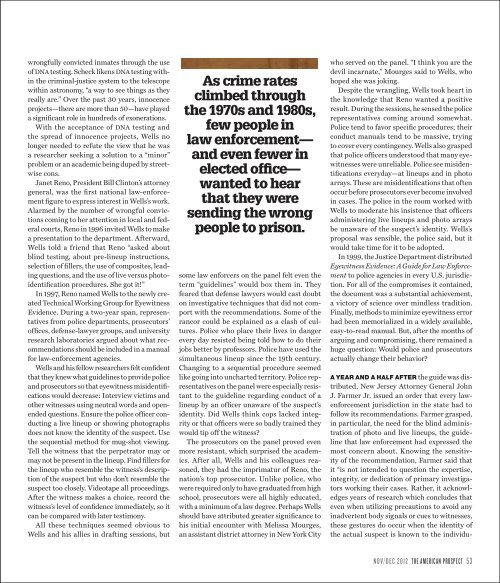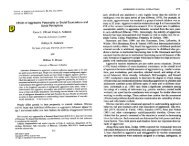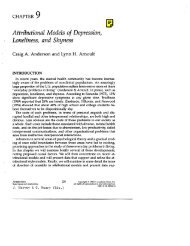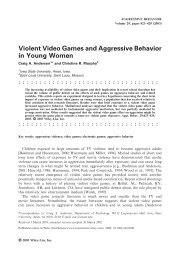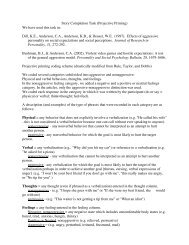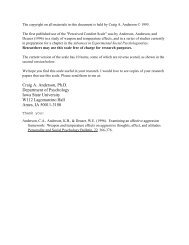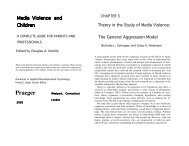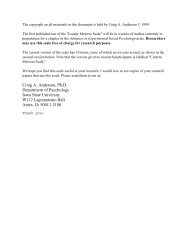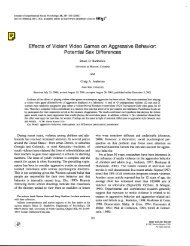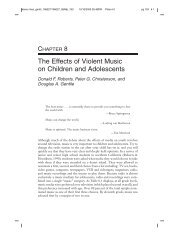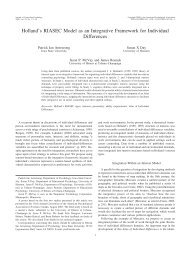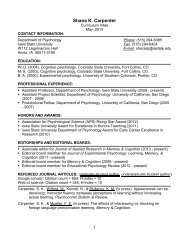Seeing is believing - Department of Psychology - Iowa State University
Seeing is believing - Department of Psychology - Iowa State University
Seeing is believing - Department of Psychology - Iowa State University
Create successful ePaper yourself
Turn your PDF publications into a flip-book with our unique Google optimized e-Paper software.
wrongfully convicted inmates through the use<br />
<strong>of</strong> DNA testing. Scheck likens DNA testing within<br />
the criminal-justice system to the telescope<br />
within astronomy, “a way to see things as they<br />
really are.” Over the past 30 years, innocence<br />
projects—there are more than 50—have played<br />
a significant role in hundreds <strong>of</strong> exonerations.<br />
With the acceptance <strong>of</strong> DNA testing and<br />
the spread <strong>of</strong> innocence projects, Wells no<br />
longer needed to refute the view that he was<br />
a researcher seeking a solution to a “minor”<br />
problem or an academic being duped by streetw<strong>is</strong>e<br />
cons.<br />
Janet Reno, President Bill Clinton’s attorney<br />
general, was the first national law-enforcement<br />
figure to express interest in Wells’s work.<br />
Alarmed by the number <strong>of</strong> wrongful convictions<br />
coming to her attention in local and federal<br />
courts, Reno in 1996 invited Wells to make<br />
a presentation to the department. Afterward,<br />
Wells told a friend that Reno “asked about<br />
blind testing, about pre-lineup instructions,<br />
selection <strong>of</strong> fillers, the use <strong>of</strong> composites, leading<br />
questions, and the use <strong>of</strong> live versus photoidentification<br />
procedures. She got it!”<br />
In 1997, Reno named Wells to the newly created<br />
Technical Working Group for Eyewitness<br />
Evidence. During a two-year span, representatives<br />
from police departments, prosecutors’<br />
<strong>of</strong>fices, defense-lawyer groups, and university<br />
research laboratories argued about what recommendations<br />
should be included in a manual<br />
for law-enforcement agencies.<br />
Wells and h<strong>is</strong> fellow researchers felt confident<br />
that they knew what guidelines to provide police<br />
and prosecutors so that eyewitness m<strong>is</strong>identifications<br />
would decrease: Interview victims and<br />
other witnesses using neutral words and openended<br />
questions. Ensure the police <strong>of</strong>ficer conducting<br />
a live lineup or showing photographs<br />
does not know the identity <strong>of</strong> the suspect. Use<br />
the sequential method for mug-shot viewing.<br />
Tell the witness that the perpetrator may or<br />
may not be present in the lineup. Find fillers for<br />
the lineup who resemble the witness’s description<br />
<strong>of</strong> the suspect but who don’t resemble the<br />
suspect too closely. Videotape all proceedings.<br />
After the witness makes a choice, record the<br />
witness’s level <strong>of</strong> confidence immediately, so it<br />
can be compared with later testimony.<br />
All these techniques seemed obvious to<br />
Wells and h<strong>is</strong> allies in drafting sessions, but<br />
As crime rates<br />
climbed through<br />
the 1970s and 1980s,<br />
few people in<br />
law enforcement—<br />
and even fewer in<br />
elected <strong>of</strong>fice—<br />
wanted to hear<br />
that they were<br />
sending the wrong<br />
people to pr<strong>is</strong>on.<br />
some law enforcers on the panel felt even the<br />
term “guidelines” would box them in. They<br />
feared that defense lawyers would cast doubt<br />
on investigative techniques that did not comport<br />
with the recommendations. Some <strong>of</strong> the<br />
rancor could be explained as a clash <strong>of</strong> cultures.<br />
Police who place their lives in danger<br />
every day res<strong>is</strong>ted being told how to do their<br />
jobs better by pr<strong>of</strong>essors. Police have used the<br />
simultaneous lineup since the 19th century.<br />
Changing to a sequential procedure seemed<br />
like going into uncharted territory. Police representatives<br />
on the panel were especially res<strong>is</strong>tant<br />
to the guideline regarding conduct <strong>of</strong> a<br />
lineup by an <strong>of</strong>ficer unaware <strong>of</strong> the suspect’s<br />
identity. Did Wells think cops lacked integrity<br />
or that <strong>of</strong>ficers were so badly trained they<br />
would tip <strong>of</strong>f the witness?<br />
The prosecutors on the panel proved even<br />
more res<strong>is</strong>tant, which surpr<strong>is</strong>ed the academics.<br />
After all, Wells and h<strong>is</strong> colleagues reasoned,<br />
they had the imprimatur <strong>of</strong> Reno, the<br />
nation’s top prosecutor. Unlike police, who<br />
were required only to have graduated from high<br />
school, prosecutors were all highly educated,<br />
with a minimum <strong>of</strong> a law degree. Perhaps Wells<br />
should have attributed greater significance to<br />
h<strong>is</strong> initial encounter with Mel<strong>is</strong>sa Mourges,<br />
an ass<strong>is</strong>tant d<strong>is</strong>trict attorney in New York City<br />
who served on the panel. “I think you are the<br />
devil incarnate,” Mourges said to Wells, who<br />
hoped she was joking.<br />
Despite the wrangling, Wells took heart in<br />
the knowledge that Reno wanted a positive<br />
result. During the sessions, he sensed the police<br />
representatives coming around somewhat.<br />
Police tend to favor specific procedures; their<br />
conduct manuals tend to be massive, trying<br />
to cover every contingency. Wells also grasped<br />
that police <strong>of</strong>ficers understood that many eyewitnesses<br />
were unreliable. Police see m<strong>is</strong>identifications<br />
everyday—at lineups and in photo<br />
arrays. These are m<strong>is</strong>identifications that <strong>of</strong>ten<br />
occur before prosecutors ever become involved<br />
in cases. The police in the room worked with<br />
Wells to moderate h<strong>is</strong> ins<strong>is</strong>tence that <strong>of</strong>ficers<br />
admin<strong>is</strong>tering live lineups and photo arrays<br />
be unaware <strong>of</strong> the suspect’s identity. Wells’s<br />
proposal was sensible, the police said, but it<br />
would take time for it to be adopted.<br />
In 1999, the Justice <strong>Department</strong> d<strong>is</strong>tributed<br />
Eyewitness Evidence: A Guide for Law Enforcement<br />
to police agencies in every U.S. jur<strong>is</strong>diction.<br />
For all <strong>of</strong> the comprom<strong>is</strong>es it contained,<br />
the document was a substantial achievement,<br />
a victory <strong>of</strong> science over mindless tradition.<br />
Finally, methods to minimize eyewitness error<br />
had been memorialized in a widely available,<br />
easy-to-read manual. But, after the months <strong>of</strong><br />
arguing and comprom<strong>is</strong>ing, there remained a<br />
huge question: Would police and prosecutors<br />
actually change their behavior?<br />
A year and a half after the guide was d<strong>is</strong>tributed,<br />
New Jersey Attorney General John<br />
J. Farmer Jr. <strong>is</strong>sued an order that every lawenforcement<br />
jur<strong>is</strong>diction in the state had to<br />
follow its recommendations. Farmer grasped,<br />
in particular, the need for the blind admin<strong>is</strong>tration<br />
<strong>of</strong> photo and live lineups, the guideline<br />
that law enforcement had expressed the<br />
most concern about. Knowing the sensitivity<br />
<strong>of</strong> the recommendation, Farmer said that<br />
it “<strong>is</strong> not intended to question the expert<strong>is</strong>e,<br />
integrity, or dedication <strong>of</strong> primary investigators<br />
working their cases. Rather, it acknowledges<br />
years <strong>of</strong> research which concludes that<br />
even when utilizing precautions to avoid any<br />
inadvertent body signals or cues to witnesses,<br />
these gestures do occur when the identity <strong>of</strong><br />
the actual suspect <strong>is</strong> known to the individu-<br />
nov/dec 2012 The American Prospect 53


